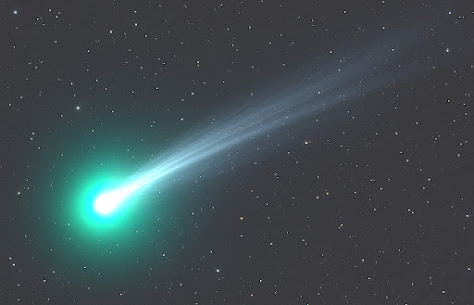Meta Description:
Discover the secrets of comets, the icy wanderers of space that light up our skies. Learn how comets are formed, what they’re made of, their role in Earth’s history, and how to observe them in 2025.
Introduction: Why Are Comets So Interesting?
For thousands of years, comets have left humans with awe, wonder and even fear; by streaking across the night sky, they often leave tail(s) visible for weeks. However beauty aside, comets are primeval messengers of ancient events in our solar system, they carry relics of our solar beginnings, and possibly clues about planets and life.
In 2025, we have already had the new green comet C/2025 F2 SWAN, and several glorious meteor showers like the Eta Aquarids, so there’s never been a better time to look up!
What Are Comets, Anyway?
Comets are icy objects made of rocks, dust, and frozen gases. Comets are often called “dirty snowballs,” and they come from two regions in our solar system:
• Kuiper Belt – Located outside the orbit of Neptune—filled with short-period comets.
• Oort Cloud – A distant cloud of ice debris—source of long-period comets.
When a comet comes close to the Sun, solar radiation causes its ices to sublimate, making a glowing coma (a cloud of gas and dust) and maybe one or more tails.
Anatomy of a Comet
To understand their brilliance, let’s break down a comet’s key components:
| Part | Description |
| Nucleus | The solid core, usually 1–10 km across, made of ice and rock. |
| Coma | A glowing halo of gas and dust up to 100,000 km wide. |
| Dust Tail | Made of fine particles; curves behind the comet. |
| Ion Tail | Composed of ionized gases; points directly away from the Sun. |
These tails can extend millions of kilometers, often making comets the largest objects in the night sky.
The Importance of Comets: Cosmic Time Capsules
Comets are remnants from the beginning of our solar system 4.6 billion years ago and are essentially frozen in time. Studying comets allows scientists to:
• Reconstruct the early solar system
• Understand how Earth got its water
• Investigate hypotheses of panspermia (when comets delivered organic materials to Earth)
For example, the Rosetta mission landed the Philae probe on comet 67P/Churyumov-Gerasimenko in 2014, and discovered organic molecules. This added considerable weight to the hypothesis that comets may have seeded early Earth with the components of life.
How to See a Comet
For most people, seeing a comet with the naked eye is a once-in-a-lifetime experience. Here’s how to see one in 2025:
Tips for Comet Watching:
- Find a dark sky: Away from city lights, ideally during new moon phases.
- Use apps like SkySafari, Stellarium, or Sky Tonight to track comet positions.
- Bring binoculars or a small telescope for enhanced views.
- Be patient: Some comets only become visible in the early morning or late evening.
Comet Spotlight for 2025:
C/2025 F2 (SWAN) had observers dazzled with its green hue April and early May 2025. Though it faded relatively quickly, we’ve once again been reminded of a spectacular but fleeting light show that nature offers.
Comets and Meteor Showers: A Galactic Connection
When Earth crosses over a comet’s dusty path, all of the debris from the comet burns up in Earth’s atmosphere, which produces a meteor shower.
Popular Meteor Showers From Comet Trails:
| Meteor Shower | Parent Comet | Peak Date | Visibility |
| Eta Aquarids | Halley’s Comet | May 5–6 | Best in Southern Hemisphere |
| Perseids | Swift–Tuttle | August 11–13 | Northern Hemisphere |
| Leonids | Tempel–Tuttle | November 17–18 | Worldwide |
Comets and Modern Science
Comets are no longer a mystery of the cosmos thanks to the Rosetta, Deep Impact, and Japan’s Hayabusa missions.
Recent Findings:
• Comets contain noble gases, such as xenon and krypton, which are useful in tracing the formation of the solar system.
• While we learned that comet 67P particulated water similar to Earth, the hydrogen isotope ratio was different to Earth’s oceans — which suggest not all of Earth’s water came from comets.
• Comets contain amino acids, some of the building blocks of proteins.
These discoveries are reviving a new wave of astrobiology research.
Fun Facts about Comets
• Halley’s Comet passes Earth approximately every 76 years. The last time Halley’s Comet was visbile was in 1986.
• The longest tail, is approximately over 500 million km long belonging to Comet Hyakutake.
• Jupiters comet Shoemaker-Levy 9 (1994), gave us our first view of what it means to collide with a comet.
Taking Photos of Comets: They are beautiful!
If you are interested in astrophotography, you will love taking pictures of comets.
Equipment Checklist:
• DSLR or mirrorless camera
• Tripod and remote shutter
• Wide-angle or telephoto lens
• Star tracker (optional)
• Editing software (e.g., Lightroom or Photoshop)
Use long exposures (10–30 seconds) and manual focus. Don’t forget to check local weather and light pollution maps.
Conclusion: The Magic of Comets
Whether it is a rare green visitor illuminating the night sky or a quiet dust trail igniting meteors, comets are the storytellers of the universe. They remind us how not only are we stargazers on Earth, but we are also passengers on a planet, occasionally grazed by visitors from the farthest edges of space.
Don’t miss out! Subscribe to our newsletter for weekly space updates, skywatching tips, and more deep dives into the universe’s most fascinating phenomena.
![]()

